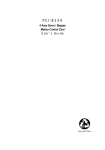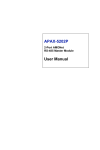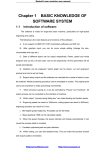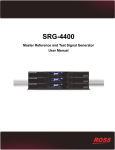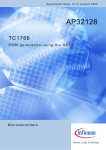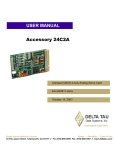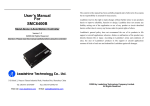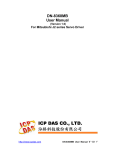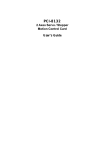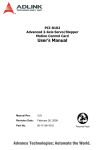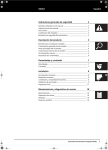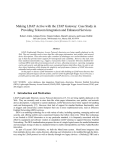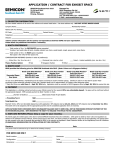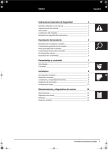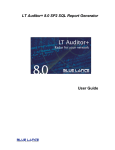Download DMC5400 - Leadshine
Transcript
Hardware Manual For 4-axis Servo/Stepping Motion Control Card Revision 1.2 ©2006 All Rights Reserved Attention: Please read this manual carefully before using the card! Floor 3, Block 2, Nanyou Tianan Industry Park, Nanshan Dist, Shenzhen, China Tel: (86)755-26434369 Fax: (86)755-26402718 URL: www.leadshine.com E-Mail: [email protected] Table of Contents Chapter 1 General Information.................................................................................................................................... 1 1.1 Introduction ................................................................................................................................................... 1 1.2 Features ......................................................................................................................................................... 2 1.3 Specifications ................................................................................................................................................ 2 1.4 Environment .................................................................................................................................................. 3 1.5 Power Consumption ...................................................................................................................................... 3 1.6 Dimension ..................................................................................................................................................... 3 1.8 Applications................................................................................................................................................... 3 1.9 Application software development ................................................................................................................ 3 Chapter 2 Installation .................................................................................................................................................. 5 2.1 Package Contents........................................................................................................................................... 5 2.2 Unpacking ..................................................................................................................................................... 5 2.3 Hardware Installation .................................................................................................................................... 5 Installation Procedures ................................................................................................................................ 5 2.4 Jumper & Switch Settings ............................................................................................................................. 6 2.4.1 Command Signal Type Settings (J1~J8)............................................................................................. 6 2.4.2 Choosing External or Internal Power Supply (J9~J10) ...................................................................... 7 2.4.3 Emergency Stop Input Signal Setting (J11)........................................................................................ 7 2.5 Power Supply Connections............................................................................................................................ 8 Chapter 3 Connectors .................................................................................................................................................. 9 3.1 X1 Connector................................................................................................................................................. 9 3.2 X2 connector ............................................................................................................................................... 10 3.3 X3 connector ............................................................................................................................................... 11 3.4 X4 connector ............................................................................................................................................... 11 Chapter 4 Interface Circuits....................................................................................................................................... 12 4.1 Pulse and Direction Signals PUL/DIR ........................................................................................................ 12 4.2 Origin Position Signal ORG ........................................................................................................................ 13 4.3 Slow Down Signal SD................................................................................................................................. 14 4.4 End Limit Signal EL+ & EL- ...................................................................................................................... 14 4.5 Encoder Feedback Signal EA, EB and EZ .................................................................................................. 15 4.6 Alarm Signal ALM ...................................................................................................................................... 17 4.7 In-Position Signal INP................................................................................................................................. 17 4.8 General Purpose Digital Input INPUT ........................................................................................................ 18 4.9 General Purpose Digital Output OUT ......................................................................................................... 18 4.10 Position Change Signal PCS...................................................................................................................... 19 4.11 Pulser Input Signals PA and PB ................................................................................................................. 20 4.12 Position Latch Signal LTC......................................................................................................................... 20 4.13 Emergency Stop Signal EMG.................................................................................................................... 21 4.14 Typical Connection for One Axis .............................................................................................................. 21 Chapter 5 Connection to Drivers ............................................................................................................................... 22 5.1 Connection to Single-ended Stepping Driver .............................................................................................. 22 5.2 Connection to Differential Stepping Driver................................................................................................. 22 5.3 Connection to Servo Driver......................................................................................................................... 22 I Hardware Manual for the DMC5400 Motion Controller Chapter 6 Motion5000 Demo Software..................................................................................................................... 24 Chapter 7 Order Information ..................................................................................................................................... 31 Chapter 8 Troubleshooting ........................................................................................................................................ 33 Appendix ................................................................................................................................................................... 35 II Hardware Manual for the DMC5400 Motion Controller Chapter 1 General Information 1.1 Introduction The DMC5400 is an advanced 4 axes motion controller card with PCI interface. It can generate pulse control signal (up to 6.5MHz) to control stepping and digital servo systems. As a motion controller, it provides any 2-axis circular interpolation, 4-axis linear interpolation, continuous interpolation with velocity continuity in multi-axes operation. In single axis operation, change position and speed on the fly are available. Multiple DMC5400 cards can be used in one system. Incremental encoder interface on all four axes provide the ability to correct positioning errors generated by inaccurate mechanical transmissions, and with the help of on board FIFO, the DMC5400 can also perform precise and extremely fast position compare and trigger function without consuming CPU resource. In addition, mechanical sensor interface, servo motor interface and general-purpose I/O signals are provided for system integration. Figure 1.1 shows the function block diagram of the DMC5400 card. The DMC5400 uses one ASIC to perform 4 axes motion control. The motion control functions include trapezoidal and S-curve velocity profiles acceleration/deceleration, circular interpolation between two axes, linear interpolation between 2~4 axes, continuous motion, in positioning and 13 home return modes are done by the ASIC. Since these functions needing complex computations are done internally on the ASIC, the PC’s CPU is free to supervise and perform other tasks. The Motion5000 Demo software, a Microsoft Windows based software is equipped with the DMC5400 card for supporting application development. The Motion5000 Demo software is very helpful for verifying and testing a motion control system during the design phase of a project. Besides this demo software, a Windows version function library is included for programmers using VB/VC/LabVIEW languages. Several sample programs are given to illustrate how to use the function library. Figure 1.1: Function block diagram of the DMC5400 Tel: +086 0755-26434369 Email: [email protected] Page: 1/36 Web Site: www.leadshine.com Hardware Manual for the DMC5400 Motion Controller 1.2 Features The following lists summarize the main features of the DMC5400 motion control card. ² 32-bit PCI-Bus plug and play. ² 4 axes of pulse and direction signal output for controlling stepping or digital servo. ² Maximum output frequency is up to 6.5 Mpps. ² Control signal types: PUL/DIR, CW/CCW. ² Trapezoidal and S-curve velocity profiles. ² Programmable acceleration and deceleration time. ² Any 2 of 4 axes circular interpolation. ² 2~4 axes linear interpolation. ² Continuous interpolation. ² Change position and speed on the fly. ² Software limit function. ² 28-bit up/down counters for incremental encoder feedbacks. ² Home switch, index signal, positive and negative limit switches interface provided for all axes. ² 4 axes high speed position latch input. ² Programmable interrupt sources. ² Simultaneous start/stop motion on multiple axes. ² Manual pulser input interface. ² Software supports up to 5 pieces DMC5400 operation in one computer. ² Motion5000 Demo software for verifying and testing a motion control system. ² DMC5400.DLL for API function calling in Windows 95/98/NT/2000/XP systems with VB/VC/LabVIEW 1.3 Specifications 1.3.1 Performances ² Number of controllable axes: 4 axes. ² Internal reference clock: 19.6608 MHz ² Pulse output frequency: 1 pps ~ 6.5 Mpps ² Position setting range: -134,217,728 ~ +134,217,728 pulses (28-bit). ² Up/down counter counting range: -134,217,728 ~ +134,217,727(28-bit). ² Linear and circular interpolation accuracies: ±0.5 LSB ² Maximum manual pulser input frequency: 100KHz ² Maximum encoder input frequency: 4MHz (×4) 1.3.2 I/O Signals ² Number of general purpose digital input: 16 (Isolated) ² Number of general purpose digital output: 16 (Isolated) ² Command signals: PUL and DIR (Non-isolated) ² Incremental encoder signals input pins: EA and EB (Isolated) ² Encoder index signal input pin: EZ (Isolated) ² Mechanical limit/switch signal input pins: ±EL, SD, PCS and ORG (Isolated) ² Servo motor interface I/O pins: INP, ALM and ERC (Isolated) Tel: +086 0755-26434369 Email: [email protected] Page: 2/36 Web Site: www.leadshine.com Hardware Manual for the DMC5400 Motion Controller ² ² ² Position latch input pin: LTC (Isolated) Pulser signal input pin: PA and PB (Non-isolated) Simultaneous start/stop signal I/O pins: STA and STP 1.4 Environment ² Operating temperature: 0℃~50℃ ² Storage temperature: -20℃~80℃ ² Humidity: 5%RH ~ 85%RH 1.5 Power Consumption ² PCI slot: +5VDC±5% @ 1100mA (Max) ² External power supply: +12 ~ 24VDC±5% @ 500mA (Max) 1.6 Dimension ² 177mm (L) × 106mm (H) 1.8 Applications ² ² ² ² ² ² ² ² Electronic assembly, measurement Semiconductor, LCD manufacturing Laser processing Laboratory automation Vision & photocomposition automation Biotech sampling and handing Robotics CNC machines 1.9 Application software development The features of the DMC5400 are made accessible by using the functions provided in the DMC5400.dll (for Windows 95/98/2000/XP). Motion5000 demo software assists the system developer in verifying and testing hardware systems. User applications may utilize the DMC5400 by calling provided functions in the DMC5400’s Dynamic Link Library (DLL) with Visual C++, Visual Basic, LabVIEW, and etc. The users can follow Figure 1.2 to build an intended application system. Tel: +086 0755-26434369 Email: [email protected] Page: 3/36 Web Site: www.leadshine.com Hardware Manual for the DMC5400 Motion Controller Figure 1.2: Application systems development flow chart Tel: +086 0755-26434369 Email: [email protected] Page: 4/36 Web Site: www.leadshine.com Hardware Manual for the DMC5400 Motion Controller Chapter 2 Installation This chapter describes how to install the DMC5400. The DMC5400 automatically configures the port and BIOS addresses. It is not necessary to configure the addresses, hence avoiding addressing conflicts. 2.1 Package Contents Besides this User's Manual (Electronic Edition), the package also includes the following items: • DMC5400 4-axis Servo/Stepping Motion Control Card (1 piece) • TB68 Terminal Board (1 piece) • Cable68-2.0 (1 piece) • TB50 Terminal Board (optional) • Cable50-2.0 (optional) • 50-pin IDE to 50-pin MCR connector with bracket (Optional) • Leadshine All-in-one CD See “Order Information” section for more information about package contents. If any of these items are missing or damaged, contact the dealer from whom you purchased the product or Leadshine. 2.2 Unpacking As with any electronic device, you should take care while handling to avoid damage from static electricity. Before removing the DMC5400 from its packaging, ground yourself to eliminate any stored static charge. The card contains electro-static sensitive components that can be easily damaged by static electricity. Therefore, the card should be handled on a grounded anti-static mat. Inspect the card module carton for obvious damage. Shipping and handling may cause damage to your module. Be sure there is no shipping and handling damage on the carton before continuing. Note: Do not attempt to install a damaged board in the computer. 2.3 Hardware Installation The DMC5400 is equipped with Plug and Play PCI controllers. It can request base addresses according to PCI standards. The system BIOS will install the system resources based on the PCI cards’ configuration registers and system parameters (also can be set by the system BIOS). The DMC5400 can be inserted into any PCI slot without any configuration modification to the system resources. Please note that the PCI system board and slot must provide bus-mastering capabilities to operate at optimum level. See “Power Consumption” section in page 3. Installation Procedures 1. Turn off your computer. Tel: +086 0755-26434369 Email: [email protected] Page: 5/36 Web Site: www.leadshine.com Hardware Manual for the DMC5400 Motion Controller 2. Remove the cover from your computer. 3. Before handling the PCI card, discharge any static buildup on your body by touching the metal case of the computer. Hold the edge of the card and do not touch the components. 4. Set the jumpers on the DMC5400 card. See “Jumper & Switch Settings” section for more information. Connect X2, X3 or X4 before installing the DMC5400 if it’s necessary. See “DMC5400 Connectors” section for more information. 5. Select a 32-bit PCI slot. 6. Position the board into the PCI slot you have selected. 7. Secure the card in place at the rear panel of the system. 2.4 Jumper & Switch Settings There are 11 jumpers (J1~J11) and one 4-bit DIP switch on the board for setting command signal types, EMG signal, EL signals, and selecting external power supply or internal power supply. See figure 2.1 for distributions of these Jumpers and Switch. Figure 2.1: Sketch drawing of the DMC5400 2.4.1 Command Signal Type Settings (J1~J8) There are 8 jumpers (J1~J8) on the DMC5400 specifically for command signal type settings. The user can use these jumpers to set PUL/DIR command signals of 1~4 axis to either single-ended (open collector) or differential. The default setting is the single-ended mode. (J1~J8 are short circuit between pin2 and pin3.) Figure 2.2: J1~J8 jumpers Table 2-1: Command signal type settings Pin Number of X1 Signal Differential Output Single-ended (Open collector) output 1 PUL0+ J1: short circuit between pin1 and pin2 J1: short circuit between pin2 and pin3 3 DIR0+ J2: short circuit between pin1 and pin2 J2: short circuit between pin2 and pin3 21 PUL1+ J3: short circuit between pin1 and pin2 J3: short circuit between pin2 and pin3 23 DIR1+ J4: short circuit between pin1 and pin2 J4: short circuit between pin2 and pin3 Tel: +086 0755-26434369 Email: [email protected] Page: 6/36 Web Site: www.leadshine.com Hardware Manual for the DMC5400 Motion Controller 55 PUL2+ J5: short circuit between pin1 and pin2 J5: short circuit between pin2 and pin3 57 DIR2+ J6: short circuit between pin1 and pin2 J6: short circuit between pin2 and pin3 Pin Number of X2 Signal Differential Output Single-ended (Open collector) output 1 PUL3+ J7: short circuit between pin1 and pin2 J7: short circuit between pin2 and pin3 3 DIR3+ J8: short circuit between pin1 and pin2 J8: short circuit between pin2 and pin3 Note: Differential signals are preferred due to their excellent noise immunity. Recommend use differential output if possible. 2.4.2 Choosing External or Internal Power Supply (J9~J10) J9 and J10 on the DMC5400 are used for choosing external or internal power supply for the card. Choosing external power supply for the card can offer higher noise immunity performances and full functions of the card. While choosing internal power supply is easier for the user to set up the system (no external power supply is needed.), but with lower noise immunity performances and no I/O functions. Here we recommend the user choosing external power supply for the card. The default mode is choosing external power supply for the card, see Figure2.3. Figure 2.3: J9~J10 jumpers 2.4.3 Emergency Stop Input Signal Setting (J11) J11 on the DMC5400 is specially used for setting effective logic level of the emergency stop signal. Jumper settings and their relative effective logic levels are shown in the Table 2-2. The default setting of the J11 is pin1 and pin2 short circuit, namely the emergency stop signal is effective when it is pulled to low level. Please check the input signal and the setting of emergency stop signal when the DMC5400 can not operate properly. Table 2-2: Emergency stop input signal setting Effective Level J11 Settings Low (EMG and EXGND is in conducting state.) Pin 1 and pin2 short circuit High (EMG and EXGND is in disconnection state.) Pin 2 and pin3 short circuit Figure 2.4: J11 jumper Tel: +086 0755-26434369 Email: [email protected] Page: 7/36 Web Site: www.leadshine.com Hardware Manual for the DMC5400 Motion Controller 2.5 Power Supply Connections Figure 2.5: Power supply connections In order to improve the anti-interference performances of the controller, the user can use two separate power supplies for PUL/DIR control signals and I/O signals of the DMC5400. VDD1-GND1 or 5V-GND1 is the power supply input ports for PUL/DIR control signals (5V-GND1 ports can be used as a power supply for customer use when use VDD1-GND1), and VDD-EXGND is the power supply input ports for I/O signals. If I/O devices generate little interference signal, then the user can use only one power supply for both PUL/DIR control signals and I/O signals. If the user has one 12~24VDC and one 5VDC power supplies, then the 12~24VDC supply can be connected to the VDD&EXGND ports and 5VDC supply can be connected to 5V&GND1 ports, while left VDD1 NOT CONNECTED (NC). Tel: +086 0755-26434369 Email: [email protected] Page: 8/36 Web Site: www.leadshine.com Hardware Manual for the DMC5400 Motion Controller Chapter 3 Connectors 3.1 X1 Connector X1 connector is a 68pin SCSI-II connector, and it contains the following signals: All signals of Axis0, Axis1, Axis2, power supply input ports for the DMC5400 and EMG input, except encoder1 and encoder2 signals, LTC1, LTC2, ERC2, 4 digital inputs and 4 digital outputs. Table 3-1: X1 connector Pin Signal IN/OUT Description (Axis) Pin Signal IN/OUT Description (Axis) 1 PUL0+ O Pulse signal(+), Axis0 35 EL0+ I End limit signal(+), Axis0 2 PUL0- O Pulse signal(-), Axis0 36 EL0- I End limit signal(-), Axis0 3 DIR0+ O Direction signal(+), Axis0 37 SD0 I* Slow down signal, Axis0 4 DIR0- O Direction signal(-), Axis0 38 ORG0 I Origin position signal, Axis0 5 EA0+ I Encoder A+, Axis0 39 ALM0 I Alarm signal, Axis0 6 EA0- I Encoder A-, Axis0 40 INP0 I* In-position signal, Axis0 7 EB0+ I Encoder B+, Axis0 41 LTC0 I Position latch input, Axis0 8 EB0- I Encoder B-, Axis0 42 PCS0 I* Position change signal, Axis0 9 EZ0+ I Encoder Z+, Axis0 43 INPUT1 I Digital input 1 10 EZ0- I Encoder Z-, Axis0 44 INPUT2 I Digital input 2 11 OUT1 O Digital output 1 45 INPUT3 I Digital input 3 12 OUT2 O Digital output 2 46 INPUT4 I Digital input 4 13 OUT3 O Digital output 3 47 INPUT5 I Digital input 5 14 OUT4 O Digital output 4 48 INPUT6 I Digital input 6 15 OUT5 O Digital output 5 49 INPUT7 I Digital input 7 16 OUT6 O Digital output 6 50 INPUT8 I Digital input 8 17 OUT7 O Digital output 7 51 OUT8 O Digital output 8 18 OUT9 O Digital output 9 52 OUT11 O Digital output 11 19 OUT10 O Digital output 10 53 OUT12 O Digital output 12 20 ERC1 O Error cleared signal, Axis1 54 ERC0 O Error cleared signal, Axis0 21 PUL1+ O Pulse signal(+), Axis1 55 PUL2+ O Pulse signal(+), Axis2 22 PUL1- O Pulse signal(-), Axis1 56 PUL2- O Pulse signal(-), Axis2 23 DIR1+ O Direction signal(+), Axis1 57 DIR2+ O Direction signal(+), Axis2 24 DIR1- O Direction signal(-), Axis1 58 DIR2- O Direction signal(-), Axis2 25 ALM1 I Alarm signal, Axis1 59 ALM2 I Alarm signal, Axis2 26 INP1 I* In-position signal, Axis1 60 INP2 I* In-position signal, Axis2 27 EL1+ I End limit signal(+), Axis1 61 EL2+ I End limit signal(+), Axis2 28 EL1- I End limit signal(-), Axis1 62 EL2- I End limit signal(-), Axis2 29 SD1 I* Slow down signal, Axis1 63 SD2 I Slow down signal, Axis2 30 ORG1 I Origin position signal, Axis1 64 ORG2 I Origin position signal, Axis2 31 PCS1 I* Position change signal, Axis1 65 PCS2 I* Position change signal, Axis2 Tel: +086 0755-26434369 Email: [email protected] Page: 9/36 Web Site: www.leadshine.com Hardware Manual for the DMC5400 Motion Controller 32 VDD1 I PUL/DIR power 1 66 EXGND - External power ground 33 5V I/O PUL/DIR power 2 / 5V Output 67 VDD I External power 12~24VDC 34 GND1 - PUL/DIR power 1 or 2 ground 68 EMG I Emergency stop signal EXGND - External power ground EXGND - External power ground * When the function is disabled, it can be use as a general purpose input. 3.2 X2 connector X2 connector is a 50pin SCSI-II connector, and it contains the following signals: All signals of Axis3, encoder1 signals, encoder2 signals, LTC1, LTC2, ERC2, VDD/EXGND, 4 digital inputs and 4 digital outputs. Table 3-2: X2 connector Pin Signal IN/OUT Description (Axis) Pin Signal IN/OUT Description (Axis) 1 PUL3+ O Pulse signal(+), Axis3 26 EL3+ I End limit signal(+), Axis3 2 PUL3- O Pulse signal(-), Axis3 27 EL3- I End limit signal(-), Axis3 3 DIR3+ O Direction signal(+), Axis3 28 SD3 I* Slow down signal, Axis3 4 DIR3- O Direction signal(-), Axis3 29 ORG3 I Origin position signal, Axis3 5 EA3+ I Encoder A+, Axis3 30 ALM3 I Alarm signal, Axis3 6 EA3- I Encoder A-, Axis3 31 INP3 I* In-position signal, Axis3 7 EB3+ I Encoder B+, Axis3 32 LTC3 I Position latch input, Axis3 8 EB3- I Encoder B-, Axis3 33 PCS3 I* Position change signal, Axis3 9 EZ3+ I Encoder Z+, Axis3 34 INPUT16 I Digital input 16 10 EZ3- I Encoder Z-, Axis3 35 INPUT15 I Digital input 15 11 OUT16 O Digital output 16 36 INPUT14 I Digital input 14 12 OUT15 O Digital output 15 37 INPUT13 I Digital input 13 13 OUT14 O Digital output 14 38 OUT13 O Digital output 13 14 ERC3 O Error cleared signal, Axis3 39 ERC2 O Error cleared signal, Axis2 15 EA1+ I Encoder A+, Axis1 40 EA2+ I Encoder A+, Axis2 16 EA1- I Encoder A-, Axis1 41 EA2- I Encoder A-, Axis2 17 EB1+ I Encoder B+, Axis1 42 EB2+ I Encoder B+, Axis2 18 EB1- I Encoder B-, Axis1 43 EB2- I Encoder B-, Axis2 19 EZ1+ I Encoder Z+, Axis1 44 EZ2+ I Encoder Z+, Axis2 20 EZ1- I Encoder Z-, Axis1 45 EZ2- I Encoder Z-, Axis2 21 LTC1 I Position latch input, Axis1 46 LTC2 I Position latch input, Axis2 22 INPUT9 I Digital input 9 47 INPUT11 I Digital input 11 23 INPUT10 I Digital input 10 48 INPUT12 I Digital input 12 24 EXGND - External power ground 49 EXGND - External power ground 25 VDD I External power 12~24VDC 50 EXGND - External power ground EXGND - External power ground EXGND - External power ground * When the function is disabled, it can be use as a general purpose input. Tel: +086 0755-26434369 Email: [email protected] Page: 10/36 Web Site: www.leadshine.com Hardware Manual for the DMC5400 Motion Controller 3.3 X3 connector X3 connector is a 12pin connector, and it contains 4 axes pulser input signals. Table 3-3: X3 connector Pin Signal Description (Axis) Pin Signal Description (Axis) 1 GND PC power ground 7 GND PC power ground 2 PA0 A phase signal of pulser, Axis0 8 PA2 A phase signal of pulser, Axis2 3 PB0 B phase signal of pulser, Axis0 9 PB2 B phase signal of pulser, Axis2 4 PA1 A phase signal of pulser, Axis1 10 PA3 A phase signal of pulser, Axis3 5 PB1 B phase signal of pulser, Axis1 11 PB3 B phase signal of pulser, Axis3 6 +5V +5V PC power supply 12 +5V +5V PC power supply 3.4 X4 connector X4 connector is a 6pin connector, and it contains simultaneous start/stop control signals for multi-card operation. Table 3-4: X4 connector Pin Signal Description (Axis) 1 GND PC power ground 2 STP Simultaneous stop signal input/output 3 STA Simultaneous start signal input/output 4 STP Simultaneous stop signal input/output 5 STA Simultaneous start signal input/output 6 +5V +5V PC power supply If there are two or more DMC5400 controllers, cascade X4 connectors of all cards for simultaneous start/stop control on all concerned axes is possible. In this case, connect X4 as follows. Figure 3.1: Simultaneous start/stop connections Tel: +086 0755-26434369 Email: [email protected] Page: 11/36 Web Site: www.leadshine.com Hardware Manual for the DMC5400 Motion Controller Chapter 4 Interface Circuits 4.1 Pulse and Direction Signals PUL/DIR The DMC5400 can output 4 axes PUL/DIR signals to control 4 stepping/digital servo motor drivers. For every axis, two pairs of PUL and DIR signals are used to send the pulse train and to indicate the direction. The PUL and DIR signals can also be programmed as CW and CCW signals pair, see “Software Manual for the DMC5400 Motion Controller” for more information. The interface circuit of the PUL and DIR signals is shown as figure 4.1. Each signal consists of a pair of differential signals. For example, the PUL0 is consisted of PUL0+ and PUL0signals. The following table shows all the PUL/DIR output signals on X1 and X2 connectors. Table 4-1: PUL/DIR pins X1 Pin Signal Description (Axis) X2 Pin Signal Description (Axis) 1 PUL0+ Pulse signal(+), Axis0 1 PUL3+ Pulse signal(+), Axis3 2 PUL0- Pulse signal(-), Axis0 2 PUL3- Pulse signal(-), Axis3 3 DIR0+ Direction signal(+), Axis0 3 DIR3+ Direction signal(+), Axis3 4 DIR0- Direction signal(-), Axis0 4 DIR3- Direction signal(-), Axis3 21 PUL1+ Pulse signal(+), Axis1 22 PUL1- Pulse signal(-), Axis1 23 DIR1+ Direction signal(+), Axis1 24 DIR1- Direction signal(-), Axis1 55 PUL2+ Pulse signal(+), Axis2 56 PUL2- Pulse signal(-), Axis2 57 DIR2+ Direction signal(+), Axis2 58 DIR2- Direction signal(-), Axis2 There are 8 jumpers (J1~J8) on the DMC5400 which can be used to set PUL/DIR command signals to either single-ended (open collector) or differential. The default settings are the single-ended modes (J1~J8 are short circuit between pin2 and pin3.). Differential signals are preferred due to their excellent noise immunity. Recommend use differential output if possible. See page6 of this manual. (a) Differential output Tel: +086 0755-26434369 Email: [email protected] Page: 12/36 Web Site: www.leadshine.com Hardware Manual for the DMC5400 Motion Controller (b) Single-ended output Figure4.1: PUL/DIR interface circuit If the PUL/DIR is set to the open collector (Single-ended) output mode, the PUL- and DIR- are used to send out signals. Please take care that the current sink to PUL- and DIR- pins must not exceed 20mA. The current may provide by the +5V PUL/DIR power source, and most of motor driver’s opto-couplers can work properly when the current is about 10mA. Have current limiting resistors in series at the PUL&DIR terminals if necessary. 4.2 Origin Position Signal ORG The origin position signals (ORG0~ORG3) are used as input signals for origin position detecting devices or mechanisms. The following table lists the relative signal name, pin number, and the axis number. Table 4-2: ORG pins X1 Pin Signal Description (Axis) X2 Pin Signal Description (Axis) 38 ORG0 Origin position signal, Axis0 29 ORG3 Origin position signal, Axis3 30 ORG1 Origin position signal, Axis1 64 ORG2 Origin position signal, Axis2 The input circuits of the ORG signals are shown as Figure 4.2. Usually, a switch is used to indicate the origin of one axis. The specifications of the limit switches should with contact capacity of +24V, 6mA minimum. An internal filter circuit is used to filter out the high frequency spike, which may cause wrong operation. When the motion controller is operated at the home return mode, the ORG signal is used to stop the output signals (PUL/DIR). See “Software Manual for the DMC5400 Motion Controller” for more detail operation of the ORG. Figure4.2: ORG signal interface circuit Tel: +086 0755-26434369 Email: [email protected] Page: 13/36 Web Site: www.leadshine.com Hardware Manual for the DMC5400 Motion Controller 4.3 Slow Down Signal SD The slow down signals (SD0~SD3) are used as input signals for slowing down the speed to the initial speed when necessary. The following table lists the relative signal name, pin number, and the axis number. Table 4-3: SD pins X1 Pin Signal Description (Axis) X2 Pin Signal Description (Axis) 37 SD0 Slow down signal, Axis0 28 SD3 Slow down signal, Axis3 29 SD1 Slow down signal, Axis1 63 SD2 Slow down signal, Axis2 The input circuits of the SD signals are shown as Figure 4.3. Usually, a switch is used to indicate the position where slowing down is necessary. The specifications of the switches should with contact capacity of +24V, 6mA minimum. An internal filter circuit is used to filter out the high frequency spike, which may cause wrong operation. See “Software Manual for the DMC5400 Motion Controller” for more detail operation of the SD. Figure4.3: SD signal interface circuit 4.4 End Limit Signal EL+ & ELThere are two end-limit signals EL+ and EL- for each axis. EL+ indicates end limit signal in positive direction and EL- indicates end limit signal in minus direction. The relative signal name, pin number and axis number are shown in the following table. Table 4-4: EL pins X1 Pin Signal Description (Axis) X2 Pin Signal Description (Axis) 35 EL0+ Positive end-limit signal, Axis0 26 EL3+ Positive end-limit signal, Axis3 36 EL0- Minus end-limit signal, Axis0 27 EL3- Minus end-limit signal, Axis3 27 EL1+ Positive end-limit signal, Axis1 28 EL1- Minus end-limit signal, Axis1 61 EL2+ Positive end-limit signal, Axis2 62 EL2- Minus end-limit signal, Axis2 The switch S1 is used to set the types of EL limit switches, see Table 4-5. The default setting of EL switch type is “normal open” type limit switch. The switch OFF is to use the “normal closed” type limit switch. The default setting is set as normal open type. Tel: +086 0755-26434369 Email: [email protected] Page: 14/36 Web Site: www.leadshine.com Hardware Manual for the DMC5400 Motion Controller Table 4-5: End limit signal setting switch DIP 0 1 2 3 ON/OFF End Limit Switch Type ON EL0± Normal Open OFF EL0± Normal Close ON EL1± Normal Open OFF EL1± Normal Close ON EL2± Normal Open OFF EL2± Normal Close ON EL3± Normal Open OFF EL3± Normal Close Figure 4.4: End limit signal setting switch The signals connection and relative circuit diagram is shown in the following diagram. The external limit switches featuring a contact capacity of +24V, 6mA minimum. An internal filter circuit is used to filter out the high frequency spike, which may cause wrong operation. You can use either normal open switch or normal closed switch by setting the DIP switch S1. The default setting is set as normal open type. See “Software Manual for the DMC5400 Motion Controller” for more detail operation of the EL. Figure 4.5: EL signal interface circuit 4.5 Encoder Feedback Signal EA, EB and EZ The encoder feedback signals include the EA, EB, and EZ. Every axis has six pins for three differential pairs of phase-A (EA), phase-B (EB) and index (EZ) inputs. The EA and EB are used for position counting, and the EZ is used for zero position index. The relative signal names, pin numbers and the axis number are shown in the following tables. Table 4-6: EA, EB and EZ pins X1 Pin 5 Signal Signal Description (Axis) Encoder A+, Axis0 X2 Pin 15 EA1+ 6 EA0- Encoder A+, Axis0 Encoder A-, Axis0 16 EA1- Encoder A-, Axis0 7 EB0+ Encoder B+, Axis0 17 EB1+ Encoder B+, Axis0 8 EB0- Encoder B-, Axis0 18 EB1- Encoder B-, Axis0 EA0+ Tel: +086 0755-26434369 Description (Axis) Email: [email protected] Page: 15/36 Web Site: www.leadshine.com Hardware Manual for the DMC5400 Motion Controller 9 EZ0+ Encoder Z+, Axis0 19 EZ1+ Encoder Z+, Axis0 10 EZ0- Encoder Z-, Axis0 20 EZ1- Encoder Z-, Axis0 40 EA2+ Encoder A+, Axis0 41 EA2- Encoder A-, Axis0 42 EB2+ Encoder B+, Axis0 43 EB2- Encoder B-, Axis0 44 EZ2+ Encoder Z+, Axis0 45 EZ2- Encoder Z-, Axis0 5 EA3+ Encoder A+, Axis0 6 EA3- Encoder A-, Axis0 7 EB3+ Encoder B+, Axis0 8 EB3- Encoder B-, Axis0 9 EZ3+ Encoder Z+, Axis0 10 EZ3- Encoder Z-, Axis0 Connection to Line Driver Output (Differential Encoder) To drive the encoder input, the driver output must provide at least 3.5V across the differential pairs with at least 6 mA driving capability. The ground level of the two sides must be tight together too. Figure 4.6: Connection to line driver output (differential encoder) Connection to Open Collector Output (Single-ended Encoder) To connect with open collector output, an external power supply is necessary. Some motor drivers also provide the power source. The connection between the DMC5400, encoder, and the power supply is shown in the following diagram. Please note that the external current limiting resistor R is necessary to protect the DMC5400 input circuit. Table 4-7 lists the suggested resistor value according to the encoder power supply. Figure 4.7: Connection to open collector output (single-ended encoder) Tel: +086 0755-26434369 Email: [email protected] Page: 16/36 Web Site: www.leadshine.com Hardware Manual for the DMC5400 Motion Controller Table 4-7: External resistor for open collector output (single-ended encoder) VDD External Resistor R +5V 0Ω +12V 1.8KΩ +24V 4.3KΩ 4.6 Alarm Signal ALM The alarm signal ALM is used to indicate the alarm status from the servo driver. When the ALM signal is active, the DMC5400 will stop the output signals (PUL/DIR). The following table lists the relative signal name, pin number, and the axis number. When the function is disabled, these ports can be use as general purpose inputs. Table 4-8: ALM pins X1 Pin Signal Description (Axis) X2 Pin Signal Description (Axis) 39 ALM0 Alarm signal, Axis0 30 ALM3 Alarm signal, Axis3 25 ALM1 Alarm signal, Axis1 59 ALM2 Alarm signal, Axis2 The input circuit of alarm signal is shown in the following diagram. The external switches featuring a contact capacity of +24V, 6mA minimum. An internal filter circuit is used to filter out the high frequency spike, which may cause wrong operation. See “Software Manual for the DMC5400 Motion Controller” for more detail operation of the ALM. Figure 4.7: ALM signal interface circuit 4.7 In-Position Signal INP The in-position signal INP from the servo motor driver indicates the deviation error is zero. That is the servo position error is zero. The following table lists the relative signal name, pin number, and the axis number. When the function is disabled, these ports can be use as general purpose inputs. Table 4-9: INP pins X1 Pin Signal Description (Axis) X2 Pin Signal Description (Axis) 40 INP0 In-position signal, Axis0 31 INP3 In-position signal, Axis3 26 INP1 In-position signal, Axis1 60 INP2 In-position signal, Axis2 The in-position signals are usually from servomotor drivers. The external switches featuring a contact capacity of +24V, 6mA minimum. An internal filter circuit is used to filter out the high frequency spike, which may cause wrong operation. See “Software Manual for the DMC5400 Motion Controller” for more detail operation of the Tel: +086 0755-26434369 Email: [email protected] Page: 17/36 Web Site: www.leadshine.com Hardware Manual for the DMC5400 Motion Controller INP. Figure 4.8: INP signal interface circuit 4.8 General Purpose Digital Input INPUT The DMC5400 provides 16 general purpose digital inputs, which can be used to accept signals from switches, sensors and other devices. For example, the user can assign one general purpose digital input for servo driver’s RDY (motor driver ready) feedback signal. The following table lists the relative signal name, pin number, and the axis number. The input circuit of general purpose digital input is shown as figure 4.9. Table 4-10: General purpose digital input pins X1 Pin 43 Signal Description (Axis) Signal Description (Axis) Digital input 1 X2 Pin 22 INPUT1 INPUT9 Digital input 9 44 INPUT2 Digital input 2 23 INPUT10 Digital input 10 45 INPUT3 Digital input 3 47 INPUT11 Digital input 11 46 INPUT4 Digital input 4 48 INPUT12 Digital input 12 47 INPUT5 Digital input 5 37 INPUT13 Digital input 13 48 INPUT6 Digital input 6 36 INPUT14 Digital input 14 49 INPUT7 Digital input 7 35 INPUT15 Digital input 15 50 INPUT8 Digital input 8 34 INPUT16 Digital input 16 The external switches featuring a contact capacity of +24V, 6mA minimum. An internal filter circuit is used to filter out the high frequency spike, which may cause wrong operation. See “Software Manual for the DMC5400 Motion Controller” for more detail operation of the INPUT. Figure 4.9: Digital input interface circuit 4.9 General Purpose Digital Output OUT The DMC5400 provides 16 general purpose digital outputs, which can be used for controlling relays, magnetic valves and other devices. For example, the user can assign one general purpose digital output for servo driver’s SVON (servo on) control signal. The following table lists the relative signal name, pin number, and the axis number. The output circuit of general purpose digital output is shown as figure 4.10. Tel: +086 0755-26434369 Email: [email protected] Page: 18/36 Web Site: www.leadshine.com Hardware Manual for the DMC5400 Motion Controller Table 4-11: General purpose digital output pins X1 Pin Signal Description (Axis) X2 Pin Signal Description (Axis) 11 OUT1 Digital output 1 38 OUT13 Digital output 13 12 OUT2 Digital output 2 13 OUT14 Digital output 14 13 OUT3 Digital output 3 12 OUT15 Digital output 15 14 OUT4 Digital output 4 11 OUT16 Digital output 16 15 OUT5 Digital output 5 16 OUT6 Digital output 6 17 OUT7 Digital output 7 51 OUT8 Digital output 8 18 OUT9 Digital output 9 19 52 OUT10 Digital output 10 OUT11 Digital output 11 53 OUT12 Digital output 12 Figure 4.10: Digital output interface circuit Note: Do please to add a fly-wheel diode for R to protect the OUTPUT port from failure, if it’s an inductance load. 4.10 Position Change Signal PCS The position change signal PCS is used for changing target position during the motor is running. When it’s effective, the controller will change the current target position setting to the new target position setting. Namely, it’s a trigger signal for changing target position. The following table lists the relative signal name, pin number, and the axis number. When the function is disabled, these ports can be use as general purpose inputs. Table 4-12: PCS pins X1 Pin Signal Description (Axis) X2 Pin Signal Description (Axis) 42 PCS0 Position Change Signal, Axis0 33 PCS3 Position Change Signal, Axis3 31 PCS1 Position Change Signal, Axis1 65 PCS2 Position Change Signal, Axis2 The input circuit of position change signal is shown as figure 4.11. The external switches featuring a contact capacity of +24V, 6mA minimum. An internal filter circuit is used to filter out the high frequency spike, which may cause wrong operation. See “Software Manual for the DMC5400 Motion Controller” for more detail operation of the PCS. Tel: +086 0755-26434369 Email: [email protected] Page: 19/36 Web Site: www.leadshine.com Hardware Manual for the DMC5400 Motion Controller Figure 4.11: PCS signal interface circuit 4.11 Pulser Input Signals PA and PB The DMC5400 can accept the input signals from pulser or JOG device signals through connector X3. The behavior of pulser or JOG device is as an encoder. The signals are usually used to generate the position information which guides the motor to follow. The interface circuits are shown as Figure 4.12. The X3 contains two +5V power supplies for pulser, if the signal voltage of pulser is not +5V or if the pulser is distantly placed, it is recommended to put an optocoupler or line driver in between. Also, +5V and GND power lines of X3 are direct from the PCI bus. Please carefully use these signals because they are not isolated. Table 4-13: PA and PB pins X3 Pin Signal Description (Axis) X3 Pin Signal Description (Axis) 2 PA Phase A Signal, Axis0 8 PA Phase A Signal, Axis2 3 PB Phase B Signal, Axis0 9 PB Phase B Signal, Axis2 4 PA Phase A Signal, Axis1 10 PA Phase A Signal, Axis3 5 PB Phase B Signal, Axis1 11 PB Phase B Signal, Axis3 Figure 4.12: PA and PB signals interface circuit 4.12 Position Latch Signal LTC The DMC5400 provides 4 position latch inputs, which can trigger the DMC5400 to capture the counter values. It gives a precise position determination. The following table lists the relative signal name, pin number, and the axis number. Table 4-13: LTC pins X1 Pin Signal Description (Axis) X2 Pin Signal Description (Axis) 41 LTC0 Position Latch Signal, Axis0 21 LTC1 Position Latch Signal, Axis1 46 LTC2 Position Latch Signal, Axis2 32 LTC3 Position Latch Signal, Axis3 Tel: +086 0755-26434369 Email: [email protected] Page: 20/36 Web Site: www.leadshine.com Hardware Manual for the DMC5400 Motion Controller The input circuit of position latch signal is shown as Figure 4.13. The external switches featuring a contact capacity of +24V, 6mA minimum. An internal filter circuit is used to filter out the high frequency spike, which may cause wrong operation. See “Software Manual for the DMC5400 Motion Controller” for more detail operation of the LTC. Figure 4.13: LTC signal interface circuit 4.13 Emergency Stop Signal EMG The emergency stop signal EMG is used to stop motion of all axes. Please check the EMG signal logic setting (J11 jumper) and the EMG signal when the card can not work properly. The interface circuits are shown as Figure 4.14. The external switches featuring a contact capacity of +24V, 6mA minimum. An internal filter circuit is used to filter out the high frequency spike, which may cause wrong operation. Figure 4.14: EMG signal interface circuit 4.14 Typical Connection for One Axis The DMC5400 has 2 end limit signal, 1 slow down signal, and 1 Origin position signal for each axis. For reliable response and better anti-interference performances, all of these signals have filter circuits in their input circuits. A typical connection for one axis is shown as Figure 4.15. Figure 4.15: Typical connection for one axis Tel: +086 0755-26434369 Email: [email protected] Page: 21/36 Web Site: www.leadshine.com Hardware Manual for the DMC5400 Motion Controller Chapter 5 Connection to Drivers 5.1 Connection to Single-ended Stepping Driver Figure 5.1 shows how to connect the DMC5400 to a single-ended stepping driver. Here take Leadshine M325 stepping driver for example. Please refer to user’s manual of the driver for more information about wirings. Figure 5.1: Connection to single-ended stepping driver 5.2 Connection to Differential Stepping Driver Figure 5.2 shows how to connect the DMC5400 to a differential stepping driver. Here take Leadshine M880 stepping driver for example. Please refer to user’s manual of the driver for more information about wirings. Figure 5.2: Connection to differential stepping driver 5.3 Connection to Servo Driver Figure 5.3 shows how to connect the DMC5400 to a differential servo driver. Here take Panasonic servo driver for Tel: +086 0755-26434369 Email: [email protected] Page: 22/36 Web Site: www.leadshine.com Hardware Manual for the DMC5400 Motion Controller example. Please refer to user’s manual of the driver for more information about wirings. Figure 5.3: Connection to servo driver Please consult user’s manual for the driver and this manual when wiring the system. Welcome to contact us at [email protected], if you have any question or meet any problem. Tel: +086 0755-26434369 Email: [email protected] Page: 23/36 Web Site: www.leadshine.com Hardware Manual for the DMC5400 Motion Controller Chapter 6 Motion5000 Demo Software The Motion5000 Demo software, a Microsoft Windows based software is equipped with the DMC5400 card for supporting application development. The Motion5000 Demo software is very helpful for verifying and testing a motion control system during the design phase of a project. You will see the default window, namely Motion Configuration Window like Figure6.1 after running the Motion5000 demo software. The Motion5000 includes 4 main windows. They are Motion Configuration Window, I/O Status/Control Window, Controller Configuration Window and Function Testing Window. There are four buttons on the Main Toolbar which can be used to switch these four windows. Figure 6.1: Motion5000 demo software (the Motion Configuration Window, the default window) Main Toolbar 1. New File Button. It can be used to open a new program file, and it’s only active in the Function Testing Window. 2. Open File Button. It can be used to open an existed program file, and it’s only active in the Function Testing Window. 3. Save File Button. It can be used to save a program file, and it’s only active in the Function Testing Window. 4. Run Program Button. It can be used to run a program file, and it’s only active in the Function Testing Window. 5. Emergency Stop Button. It can be used to stop a running a program file. Tel: +086 0755-26434369 Email: [email protected] Page: 24/36 Web Site: www.leadshine.com Hardware Manual for the DMC5400 Motion Controller 6. Motion Configuration Window Button. It can be used to switch back to the Motion Configuration Window (the default window) when in other windows. 7. I/O Status/Control Window Button. It can be used to switch to the I/O Status/Control Window. 8. Controller Configuration Window Button. It can be used to switch to the Controller Configuration Window. 9. Function Testing Window Button. It can be used to switch to the Function Testing Window. Command Signal and Encoder Signal Display Labels The Command Signal and Encoder Signal Display Labels display current command signals and encoder signals of all axes in all windows. The unit is pulse. Controller List The Controller List will list all controllers in the current system, and the user can select which controller is going to be operated in the Motion5000. Zero based, No. 0 Card, No.1 Card, ···, No.n Card. Motion Configuration Window In the Motion Configuration Window, the user can configure some key parameters for a motion testing, such as S-Curve velocity profile, motion direction, motion type, which axis/axes to move, and etc. And can start a motion testing, stop a motion testing and clear command & encoder counters. See Figure 6.1. Figure 6.2: I/O Status/Control Window I/O Status/Control Window In the I/O Status/Control Window, the user can see the current status of special purpose inputs, general purpose inputs and general purpose outputs. Also, the user can use the small buttons on the right side of outputs to change the status of outputs. Green means ON, and Red means OFF. See Figure 6.2. Tel: +086 0755-26434369 Email: [email protected] Page: 25/36 Web Site: www.leadshine.com Hardware Manual for the DMC5400 Motion Controller Figure 6.3: PUL/DIR signal configuration tab (the Controller Configuration Window) PUL/DIR Signal Configuration Tab (Controller Configuration Window) In the PUL/DIR signal configuration tab of the Controller Configuration Window, the user can configure pulse signals and direction signals of all axes. 1. Select appropriate Command Signal Settings a. Select PUL/DIR means select PUL/DIR (Pulse/Direction) mode. b. Select CW/CCW means select CW/CCW (clock wise/counter clock wise) mode. c. Select Pulser Input means select pulser input mode. 2. Select appropriate Pulse Signal Settings a. Select Active on Falling Edge means the active edge of pulse signal is falling edge. b. Select Active on Rising Edge means the active edge of pulse signal is rising edge. 3. Select appropriate Direction Signal Settings a. Select Positive when LOW Logic and Negative when HIGH Logic means the pulse counter will increases when direction signal is at LOW level and will decreases when direction signal is at HIGH level. b. Select Positive when HIGH Logic and Negative when LOW Logic means the pulse counter will increases when direction signal is at HIGH level and will decreases when direction signal is at LOW level. c. Select Positive when Phase A leads Phase B means the pulse counter will increases when the controller receives pulse input signal from A phase input port and will decreases when the controller receives pulse input signal from B phase input port. Only active when select Pulser Input in Command Types panel. d. Select Positive when Phase B leads Phase A means the pulse counter will increases when the controller receives pulse input signal from B phase input port and will decreases when the controller receives pulse input signal from A phase input port. Only active when select Pulser Input in Command Types panel. See more information about PUL/DIR configuration and d5400_set_pulse_outmode function descriptions in Tel: +086 0755-26434369 Email: [email protected] Page: 26/36 Web Site: www.leadshine.com Hardware Manual for the DMC5400 Motion Controller “Software Manual for the DMC5400 Motion Controller Motion Controller”. Figure 6.4: Servo control signal configuration tab (the Controller Configuration Window) Servo Control Signal Configuration Tab (Controller Configuration Window) In the Servo Control signal configuration tab of the Controller Configuration Window, the user can configure in-position signals, alarm signals and encoder signals of all axes. 1. Select appropriate INP Signal Settings a. Select Disable in INP signal panel means disable In-Position feedback function, and the INP input port can be used as a general purpose input when disable In-Position feedback function. b. Select Enable in INP signal panel means enable In-Position feedback function. In this situation, the motion status flag, namely the result from the d5400_check_done function has to wait for INP to be active before turning into 1(motion stop status flag), even the controller has stopped output pulses actually. c. Select Active LOW in INP signal panel means the active logic level of the In-Position signal is LOW level. d. Select Active HIGH in INP signal panel means the active logic level of the In-Position signal is High level. 2. Select appropriate Alarm Signal Settings a. Select Immediately Stop in ALM signal panel means the controller stops output pulse command signals immediately when the ALM signals are active. b. Select Stop with Deceleration in ALM signal panel means the output PUL signals will decelerate at the deceleration values specified by velocity profile setting functions when the ALM signals are active. c. Select Active LOW in ALM signal panel means the active logic level of the Alarm signal is LOW level. d. Select Active HIGH in ALM signal panel means the active logic level of the Alarm signal is High level. 3. Select appropriate Encoder Counter Settings a. Select 1×A/B means count increments once every four quad states, ×1 A/B b. Select 2×A/B means count increments once every two quad states, ×2 A/B c. Select 4×A/B means count increments once every quad state, ×4 A/B d. Select CW/CCW means pulse from EA causes the counter to count up, whereas pulse from EB causes the Tel: +086 0755-26434369 Email: [email protected] Page: 27/36 Web Site: www.leadshine.com Hardware Manual for the DMC5400 Motion Controller counter to count down. Figure 6.5: Home return configuration tab (the Controller Configuration Window) Home Return Configuration Tab (Controller Configuration Window) In the Home Return Configuration Tab of the Controller Configuration Window, the user can configure origin position signals, home return speed for searching origin position signals and searching origin position modes of all axes. 1. Select appropriate ORG Active Logics a. Select Active HIGH in ORG Active Logics panel means the effective logic level of the origin position signal is High level. b. Select Active LOW in ORG Active Logics panel means the effective logic level of the origin position signal is LOW level. 2. Select appropriate Home Return Velocity Settings a. Select Starting Velocity in Home Return Velocity panel means the controller will search origin position signals at the Starting Velocity specified by velocity profile setting functions. b. Select Maximum Velocity in Home Return Velocity panel means the controller will search origin position signals at the Maximum Velocity specified by velocity profile setting functions. 3. Select appropriate ORG Signal Searching Mode Settings a. Select Single Direction in Home Return Modes panel means the controller will stop output pulses once it receives the origin position signals. b. Select Repeat Search in Home Return Modes panel means the controller will return back for a litter distance when it receives the origin position signals at the Starting Velocity specified by velocity profile setting functions, and then search the origin position signals again at the Starting Velocity values. Tel: +086 0755-26434369 Email: [email protected] Page: 28/36 Web Site: www.leadshine.com Hardware Manual for the DMC5400 Motion Controller Figure 6.6: End limit signal configuration tab (the Controller Configuration Window) End Limit Signal Configuration Tab (Controller Configuration Window) In the End Limit Signal Configuration Tab of the Controller Configuration Window, the user can configure end limit stop mode, position comparison signal and software limit of all axes. 1. Select appropriate End Limit Stop Mode Signal Settings a. Select Immediately Stop in Hardware End-limit Stop Modes panel means the controller will stop output pulse command signals immediately when the EL signals are active. b. Select Stop with Deceleration in Hardware End-limit Stop Modes panel means the output pulse signals will decelerate at the deceleration values specified by velocity profile setting functions when the EL signals are active. 2. Select appropriate Position Comparison Signal Settings a. Select Command Positions in Compare Position Selections panel means the controller will compare command positions to software limit position settings to detect whether the system has reaches the software limits or not. b. Select Encoder Feedbacks in Compare Position Selections panel means the controller will compare encoder feedbacks to software limit position settings to detect whether the system has reaches the software limits or not. 3. Select appropriate Software Limit Enable/Disable Settings a. Select Disable in Software End Limit panel means disable the software limit function. b. Select Enable in Software End Limit panel means enable the software limit function. 4. Select appropriate Software End Limit Stop Mode Settings a. Select Immediately Stop in Software End Limit Stop Modes panel means the controller will stop output pulse command signals immediately when negative overtravel or positive overtravel appears. b. Select Stop with Deceleration in Software End Limit Stop Modes panel means the output pulse signals will decelerate at the deceleration values specified by velocity profile setting functions when negative overtravel or Tel: +086 0755-26434369 Email: [email protected] Page: 29/36 Web Site: www.leadshine.com Hardware Manual for the DMC5400 Motion Controller positive overtravel appears. 5. Select appropriate Software Limit Position Settings a. Negative Limit in Software End Limit Positions panel means the software limit position in negative direction. b. Positive Limit in Software End Limit Positions panel means the software limit position in positive direction. Figure 6.7: Function Testing Window Function Testing Window In the Function Testing Window, the user can test most functions of the DMC5400 except the functions which have array variables. 1. Function List Function List Panel shows most API functions of the DMC5400 to help user to program. 2. Current Function Current Function Panel shows the function that the user selected or the closest function that match the user enters. 3. Current Function Prompts Current Function Prompts Panel shows the prompts for the current function. 4. Program List Program List shows the current program, and the user can edit the program in this panel. The user can run the program when finish programming or stop a running program with the button on the Main Toolbar. Refer to “Software Manual for the DMC5400 Motion Controller Motion Controller” for more information about API functions of the DMC5400. Tel: +086 0755-26434369 Email: [email protected] Page: 30/36 Web Site: www.leadshine.com Hardware Manual for the DMC5400 Motion Controller Chapter 7 Order Information Besides this User's Manual (Electronic Edition), the package also includes the following items: l DMC5400 4-axis Servo/Stepping Motion Control Card (1 piece) Figure 7.1: The DMC5400 l TB68 Terminal Board (1 piece) Figure 7.2: The TB68 terminal board l Cable68-2.0 (1 piece) Figure 7.3: The Cable68-2.0 l TB50 Terminal Board (optional) Figure 7.4: The TB50 Terminal Board l Cable50-2.0 (optional) Figure 7.5: The Cable50-2.0 Tel: +086 0755-26434369 Email: [email protected] Page: 31/36 Web Site: www.leadshine.com Hardware Manual for the DMC5400 Motion Controller l 50-pin IDE to 50-pin MCR connector with bracket (Optional) Figure 7.6: The 50-pin IDE to 50-pin MCR connector with bracket l Leadshine All-in-one CD If no Leadshine All-in-one CD was distributed with the DMC5400, then all materials are available on the internet, and the customers can download them from Leadshine’s website at: www.leadshine.com. l Connect the DMC5400 to the terminal boards. Figure 7.7: Connect the DMC5400 to the terminal boards If any of these items is missing or damaged, contact the dealer from whom you purchased the product or Leadshine. Tel: +086 0755-26434369 Email: [email protected] Page: 32/36 Web Site: www.leadshine.com Hardware Manual for the DMC5400 Motion Controller Chapter 8 Troubleshooting Many of the problems that affect motion control systems can be traced to software errors, mistake in wiring, or electrical noise. In the event that your DMC5400 doesn’t operate properly, the first step is to identify whether the problem is software or hardware in nature. The next step is to isolate the system component that is causing the problem. As part of this process you may have to disconnect the individual components that make up your system and verify that they operate independently. It is important to document each step in the troubleshooting process. You may need this documentation to refer back to at a later date, and these details will greatly assist our Technical Support staff in determining the problem should you need assistance. If the DMC5400 still can’t operate properly after following the troubleshooting form, please contact Leadshine Technical Support staff at: [email protected]. Table 6-1: Troubleshooting form Symptoms Possible Problems 1. The driver has not been installed correctly. Remove the driver and uninstall the DMC5400, then reinstall the driver according with “Driver installation” section in “Software Manual for the DMC5400 Motion Controller”. The host computer can’t 2. The DMC5400 has not been installed in PCI slot correctly. Make sure the DMC5400 find the DMC5400. is installed in a good PCI slot; clear the gold fingers and PCI slot if necessary and then reinstall the DMC5400. 3. Conflict with the computer mainboard or other hardware. 4. The DMC5400 failure; contact Leadshine for help or repair. Can’t with communicate the application 1. The host computer can’t find the DMC5400, see above contents. 2. The DMC5400 has not been initialized before calling other functions. Please call software or can’t call d5400_board_init function to initialize the DMC5400 before calling other functions. API functions 3. The DMC5400 failure; contact Leadshine for help or repair. 1. Wrong wiring. Wiring correctly and fix wires firmly. 2. Motor driver or motor failure. 3. The PUL/DIR control signal type has not been correctly set. See descriptions about J1-J8 jumpers and d5400_set_pulse_outmode function. 4. No PUL/DIR control signal output from the DMC5400, please check the J9&J10 setting and the power supply for PUL/DIR control signals. Motor doesn’t move. 5. The emergency stop signal EMG is effective. Please check the EMG signal logic setting (J11) and the EMG signal. 6. The alarm signal ALM is effective. Please check the ALM signal logic setting and the ALM signal. 7. The PUL/DIR control signal is too weak causing by too large current limit resistor in series with the driver. 8. The DMC5400 failure; contact Leadshine for help or repair. Tel: +086 0755-26434369 Email: [email protected] Page: 33/36 Web Site: www.leadshine.com Hardware Manual for the DMC5400 Motion Controller 1. The PUL/DIR control signal is too weak causing by too large current limit resistor in series with the driver. Erratic motor motion or inaccuracy positioning 2. The PUL/DIR control signal is interfered. 3. Wrong motor connection. 4. Motor broken or something wrong with motor coil. 5. Current setting of the motor driver is too small. 6. The DMC5400 failure; contact Leadshine for help or repair. 1. The encoder signal is not a TTL signal. Use an encoder whose signals are TTL compatible. 2. Encoder wiring is wrong. Wiring encoder correctly and fix wires firmly. 3. Encoder has not been powered correctly. Check the power supply for encoder. Can’t count correctly. 4. The feedback signals are corrupted by noise signal (s). Please increase noise immunity of feedback signals, such as using shielded cable(s) and good grounding. 5. Called a wrong function or right function but with wrong parameter(s). Please call the correct function with correct parameter(s). 6. Encoder failure. 7. The DMC5400 failure; contact Leadshine for help or repair. 1. Wrong wiring. Wiring correctly and fix wires firmly. Fail to capture counter 2. Called a wrong function or right function but with wrong parameter(s). Please call value or can but with the correct function with correct parameter(s). poor reliability. 3. Trigger signal is a dither signal. 4. The DMC5400 failure; contact Leadshine for help or repair. 1. Wrong wiring. Wiring correctly and fix wires firmly. 2. Called a wrong function or right function but with wrong parameter(s). Please call Fail to read input signal(s). the correct function with correct parameter(s). 3. Input device(s)/sensor(s) failure. 4. Input signal is interfered. 5. The DMC5400 failure; contact Leadshine for help or repair. 1. Wrong wiring. Wiring correctly and fix wires firmly. Fail to control output 2. Called a wrong function or right function but with wrong parameter(s). Please call port(s). the correct function with correct parameter(s). 3. The DMC5400 failure; contact Leadshine for help or repair. Tel: +086 0755-26434369 Email: [email protected] Page: 34/36 Web Site: www.leadshine.com Hardware Manual for the DMC5400 Motion Controller Appendix Encoder Input Signal: Input Ports EAn+/-, EBn+/-, EZn+/Up/down pulse Encoder Counting Encoder Input Signal A/B phase pulse (X1,X2,X4) Input Frequency (Max.) Encoder Supply 1MHz (Before X4) 5V, then R=0Ω Low Level: 0.8 VDC (Max) High Level: 2.4 VDC (Min) 12V, then R=1.8K Low Level: 3.0 VDC (Max) High Level: 10.0 VDC (Min) 24V, then R=4.7K Low Level: 3.0 VDC (Max) High Level: 12.0 VDC (Min) Protection 2500VDC Optically Isolated External Pulse Input: External Signal Drive Input Ports PA, PB Input Frequency (Max.) 100Hz Signal Type(TTL) Devices Low Level 0.8V (Max) High Level 2.4V (Min) Manual Pulser, JOG Devices, and etc. Digital Input and Output: Input End Limiting Signal EL+, EL- Slow Down and Origin Position Signal SD,ORG Servo Status Feedback ALM(Alarm), INP(In Position) Emergency Stop EMG Input Frequency 4KHz Number of Input 16 Input Current Output Tel: +086 0755-26434369 10VDC 1.70mA(Typical) 12VDC 2.10mA(Typical) 24VDC 4.40mA(Typical) 48VDC 9.00mA(Typical) 50VDC 9.40mA(Typical) Protection 2500VDC Optically Isolated and RC Filter Number of Output 16 Output Voltage Capacity Open Collector 5~40VDC Output Current 60mA(Max)/channel Protection 2500VDC Optically Isolated and RC Filter Email: [email protected] Page: 35/36 Web Site: www.leadshine.com Hardware Manual for the DMC5400 Motion Controller Electromagnetic Compatibility Standards to which Conformity is Declared: EN61000-6-2:2005 EN55011:1997+A1:1999+A2:2002 Figure A1: CE certificate Tel: +086 0755-26434369 Email: [email protected] Page: 36/36 Web Site: www.leadshine.com







































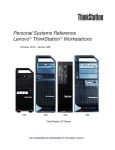
![FV1100-LNX - FAST CORPORATION[株式会社ファースト]](http://vs1.manualzilla.com/store/data/006542967_2-61dcc976f15352cc05847a1f203ad7c3-150x150.png)
